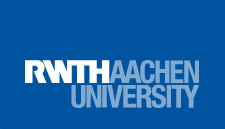Kategorie: ‘Chemistry’
Research stay in Marseille
- Chemistry M.Sc
- France, Marseille
- Aix-Marseille Université
- 06/2023 – 09/2023
The possibilities for doing an internship abroad are endless. This made it difficult for me to decide, so I had to narrow down my choices. Thanks to my professor, I got in touch with iSM2 at the University of Aix Marseille in France. It was a dream for me to live by the sea for once in my life and improve the French I
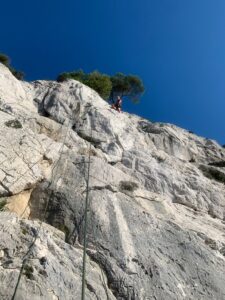
Climbing in Calanque de Sormiou
© Eveline Jagla
learned in school. I emailed my contact person at iSM2 and she was happy about my interest and offered me an internship right away.
I found my accommodation through the website “La Carte des Coloc”. For a room of about 14 m^2 in an 80 m^2 apartment with 4 bedrooms I paid about 530 € per month. The start was difficult because there was no wifi and no electricity when I arrived. We had no electricity for 3 days and I had to sign a contract with EDF myself. Luckily my contact person at iSM2 helped me with a 30 minute phone call and we had electricity. But the tale of woe with this apartment and the agency “Colivers” would not fit into this report. Short conclusion: I do not recommend “Colivers” to others…. The apartment was located in Castellane, a very good area to live. From Castellane there are two metro lines, one of the three streetcars, many buses going to Cassis, La Ciotat and Marseille beaches and 15 minutes walk to the city center “Vieux Port”. A lot of restaurants are also nearby: McDonalds, Burger King, Vapiano, Go Ramen (5/5!), Shuriken Sushi (5/5!), … The boulangerie is also across the street and open 24 hours. To buy food, there are the supermarkets: Monoprix (super expensive), Franprix (close, small and expensive), Carrefour and Lidl (further away, 10 minutes walk). Compared to Germany, food is more expensive: in the supermarket and in the restaurants. In a bar, beer costs 6-8 € (50 cl) and long drinks for the same price. For a meal in a restaurant you pay between 15 € (cheap) and 23 €. The younger people go to Cours Julien and La pleine. Here there are many bars and restaurants at a cheaper price.
A lab day was always between 9/10 and 17/18. I took the metro and then the bus, which took about 30 minutes. Unlike in Germany, the entrance to the university is guarded.
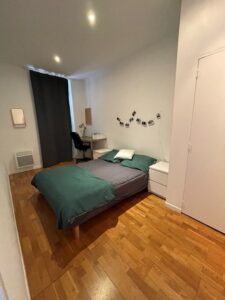
My Bedroom
© Eveline Jagla
The PhD student I was allowed to work with introduced me to her research and soon I was working independently. I was working on the catalysis of the degradation of cellobiose with LMPO-like catalysts. In a short time, I collected a lot of data using UV-Vis spectroscopy, fluorescence spectroscopy and HPLC. During the group meeting on Friday, I presented my results. The group was mixed with French, Indians, Brazilians, Spanish, Americans and probably more, everyone is welcome, and I felt very comfortable. Since I was there in the summer, the lab was pretty empty, and so was the campus. Everyone was fleeing the heat. I was able to try touch rugby on campus during a couple of practice sessions. It was a lot of fun, and I was sad that the practice was discontinued during the hot summer months. For lunch, you could bring something and eat with the others in the break room, or you could go there while the cafeteria was still open.
In my free time I spent a lot of time at the beach. My favorite places in Marseille are Vallon des Auffres, Prado (very beautiful sunset and many different beaches), Maldormé and Plage Catalans is nice because it was only 15 minutes from my apartment. I spent a lot of time in the Calanques, especially in the Calanques of Cassis. And there, the Calanque Port Pin is my favorite place. Once you reach the beach, you hike and climb a bit on the right side and then you reach a rock where you can lie down. The calanques of the Côte Bleue are also very beautiful. There my favorite place in La Redonne is
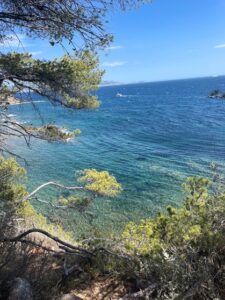
Calanque des Anthénors in La Redonne
© Eveline Jagla
the port and the Calanque des Anthénors. To visit this place you can use the TER and with the Pass Côte Bleue you only pay 5 or 6 € and you can take the train all day. Many people also like Niolon, but I haven’t managed to go there yet, but I will on my next visit. Since I am very interested in sports, I tried climbing for the first time. I did it three times in the Calanques and I also bouldered in Arkose. It was so much fun and it is definitely a sport that I will continue to do in Germany. With Monde Vertical I discovered the Calanque of Sormiou and the one in Cap Canaille. The view of the different types of rocks and the sea was fantastic!
Since I was in a shared apartment, it was easier to make friends. But I also met some people through Bumble and the Erasmus Student Network (ESN). Unfortunately, the ESN didn’t offer any activities during the summer. But Marseille is so friendly and open that it’s easy to make friends even when walking around the city alone. I was also allowed to invite four different visitors so that we could explore the city together. I also had the opportunity to travel a bit. With a friend we went to Nice and Gordes du Verdon. Gordes du Verdon was fantastic and the Aqua rando where you float through the gorge was a lot of fun with an amazing view. Nice was a nice smaller town, but you could feel the different atmosphere. People were more well dressed and seemed more arrogant. We never had any really friendly service in the restaurants…. After our trip, we were very happy to return to Marseille. That’s what I love about Marseille. You can be who you want to be, and people don’t judge you. Some other tips in Marseille are: Bouillabaisse TURFU for a delicious
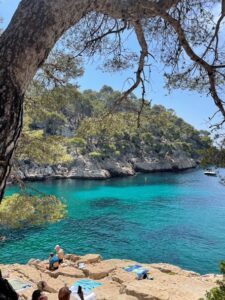
Calanque de Port Pin in Cassis
© Eveline Jagla
and small portion of bouillabaisse, Flashback at Vieux Port for a drink, co-working, lunch…, Green Meal for vegan and vegetarian food, Friche la Belle Mai as a nice event location, generally the metro card “la carte”, a visit to Cassis: a very cute little town, L’Art Haché: a hidden bar at La Pleine with jazz music (when we were there) and they only accept cash.
Feedback: Before I came to Marseille, I seemed very happy in Germany and didn’t want to leave. In the first weeks I could not imagine life in Marseille. Compared to Germany, it is very chaotic and disorganized, rules have less importance, and it is very dirty (the city has a big garbage problem…). But once I got used to the city and the lifestyle, I started to love it. I had a fresh start and could be who I wanted to be. I made some friends and the scenery with the Calanques is just amazing! I was very sad to leave Marseille and the lab, even though I didn’t quite like the topic in the internship. I gained a lot of valuable experience, and I am so grateful that I had the opportunity to be in Marseille and in the iSM2 lab! I am very sad to leave and if a new opportunity to come back to Marseille arises, I will be very happy.
My research stay in Oslo
- Chemistry M.Sc.
- Norway, Oslo
- Universitetet i Oslo
- 12.09.21-12.03.2022
Over the course of my studies, played with the idea of doing an exchange, though, for various reasons, I never went through with it. With the end of my master’s degree approaching, I decided to make use of this last chance and to complete my master thesis during a research stay at a university in another country. The planning for this started in May 2021, at the height of the second COVID wave. This narrowed my choice of countries down to all of Scandinavia, since the situation there was somewhat calm, though at this point the borders were still closed, and it wasn’t clear when they would open again. Nonetheless, I started planning.
After looking at all the major universities in Scandinavia, I found that UiO (Universitetet i Oslo) and UiB (Universitetet i Bergen) did interesting research that aligned well with my qualifications, but also with skills that I still wanted to acquire or improve. After contacting a professor at each university by e‑mail, Prof. Tilset from UiO was able to accommodate me for an interesting project in the desired timeframe.
At first, I tried to find housing privately on finn.no (Norway’s equivalent to eBay), but as a foreigner, a male, and someone staying for a mere few months, it is very difficult to find a place in shared accommodation. Thankfully, the Department of Chemistry offered to apply for researcher housing for me. Most of the student housing in Oslo is run by SiO (Studentsamskipnaden i Oslo og Akershus), a student welfare organization. Their housing is well-maintained and somewhat modern, though as a researcher you pay 20% more rent than students. Electricity, water, and internet access are included in this. This is still cheaper than the very expensive private housing in Oslo. I paid 4800 NOK in rent for a room with a shared kitchen (6 people), which is about 480 €. Having to pay more as a researcher was a recurring theme for my stay in Oslo, since I mostly didn’t get student discounts. As another bonus, you get housed with other students of Oslo’s universities, so you have ample opportunities to make friends. On the day of your arrival, it might make sense to make use of the hourly Ikea shuttles, which take people from the city centre to one of two Ikea markets (free of charge). This lets you buy the necessities for your room/apartment conveniently. The location and departure schedule can be found on Google Maps.
When staying in Norway for more than 9 weeks, it is mandatory to register with the police, where (if you’re an Erasmus intern as opposed to an Erasmus student) you have to document that you have enough money to support yourself (e.g. savings, the equivalent of 180.000 NOK per year, or less if you’re staying for a shorter time), a valid national identity card/passport and private health insurance. I did not know of the latter, but the worker at the police was kind enough to register
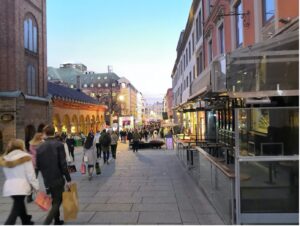
© Heiko Schiefer
me as a student when I showed her the signed agreement of the three parties and proof that I received funding from Erasmus (in my case a bank statement).
Oslo has good public transportation (Metro, Tram, Busses, and Boats), but the normal monthly ticket (800 NOK) unfortunately is constrained to the city limits, which nonetheless should cover most of your trips. Extensions can be bought in the public transportation company’s app, Ruter.
Since you will be paying in NOK, it also makes sense to open an account with a bank that charges no fees for paying in foreign currency, e.g., DKB. Credit cards are universally accepted, so there is little reason to carry cash.
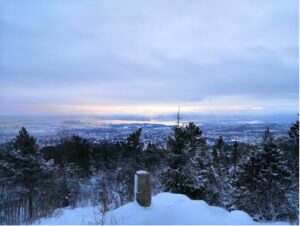
© Heiko Schiefer
For leisure activities, the Norwegians are generally very fond of the outdoors, so popular activities are ice skating, skiing, or hiking, sometimes combined with a picknick. Outdoor equipment can be borrowed free of charge at one of the many Bua’s (a non-profit organization) around Oslo. During the winter, many people sit around campfires around lake Songsvann or atop the Vettakollen mountain. These are also nice places to try and get a glimpse of the northern lights. The Norwegian trekking association (DNT) organizes trips (e.g. mushroom picking or hiking) and rents out cabins for cheap. If going out to eat is more your thing, Oslo Street Food is worth recommending. It’s a cozy food court with lots of selection, but don’t expect to be served large portions.
Here it should be mentioned that the selection of vegetarian food is more limited in Norway than in Germany, and vegan food even more so. If you’re a big partygoer, beware: Alcoholic beverages are very expensive in Norway, and only sold until 8 pm. Anything over 4.7% is only sold in the state-run Vinmonopolet shops. If you’re more culturally inclined Oslo’s many museums might be of interest.
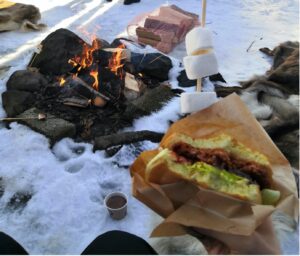
© Heiko Schiefer
Because I did not need to attend any courses, I could focus solely on my research and enjoyed lots of autonomy. The university is generally well equipped. I had my own lab bench and fume hood in a large lab with 5 other researchers (Bachelor/master students, PhDs, and a post-doc), as well as a desk in a shared office. Approximately half of the researchers were Norwegian, the other half from all over Europe. The direction and progress of my research was evaluated in weekly talks with my supervising Professor. In addition to that, there were weekly group meetings and biweekly section meetings, were people would present their research and the rest would give feedback/ask questions. The working climate was very pleasant, and I spent hours talking to fellow researchers about their or my research.
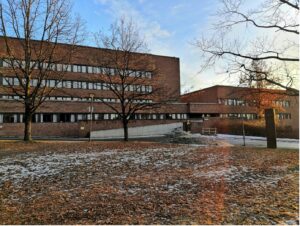
© Heiko Schiefer
In conclusion, my time in Oslo was a great experience, both professionally and personally. I got to do research abroad, acquired new skills, and refined those I already had. I met lots of new people and made friends and memories. While the cost of living is certainly high in Oslo and coming to Norway as an intern is associated with some challenges, the experience was certainly worth it.
